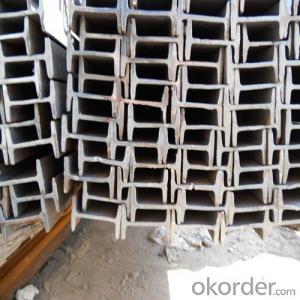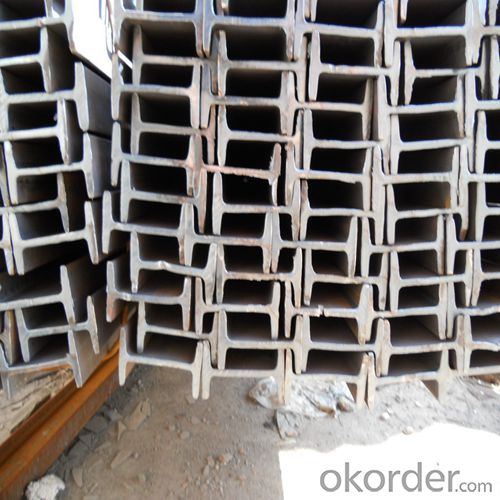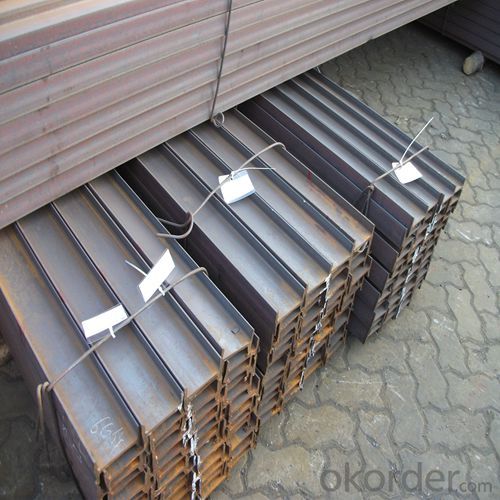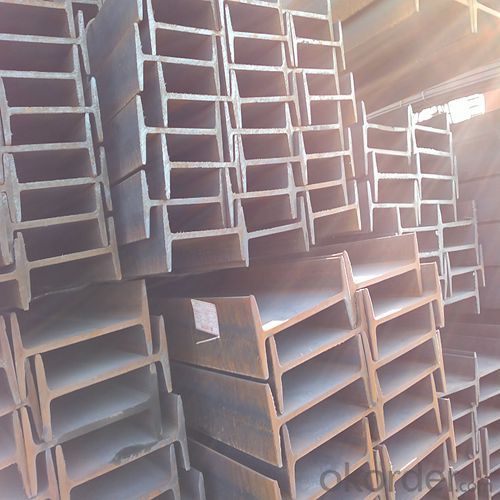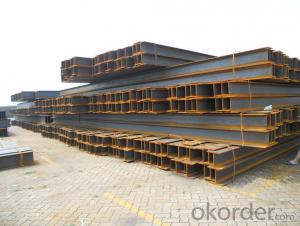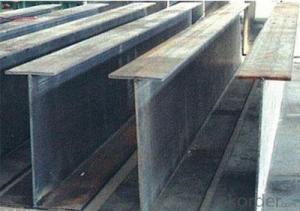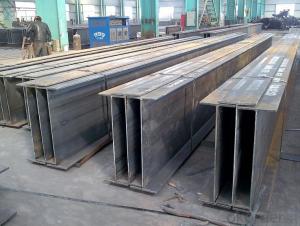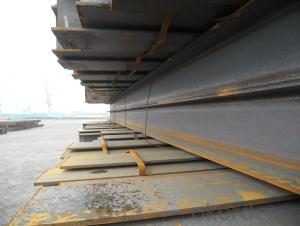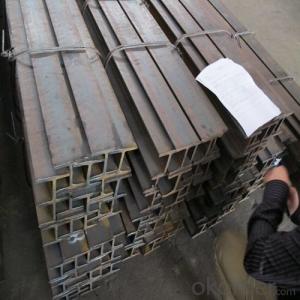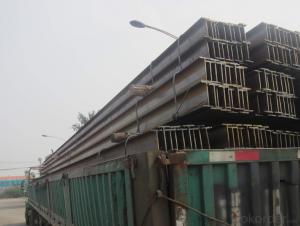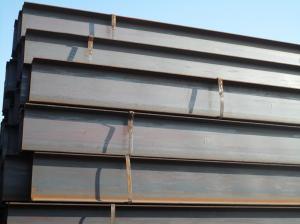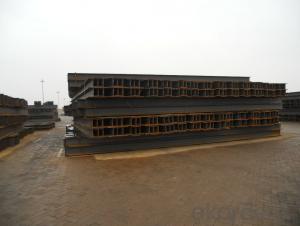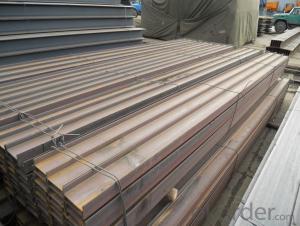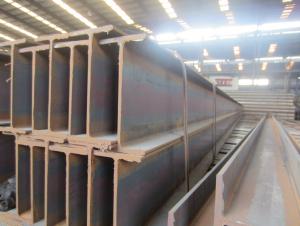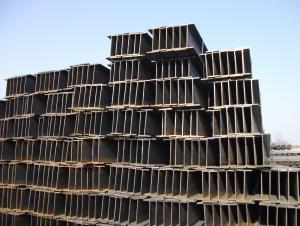HOT ROLLED STEEL H-BEAM HIGH QUALITY STRUCTURE STEEL GB JIS
- Loading Port:
- Tianjin
- Payment Terms:
- TT OR LC
- Min Order Qty:
- 100 m.t.
- Supply Capability:
- 40000 m.t./month
OKorder Service Pledge
OKorder Financial Service
You Might Also Like
Product Description:
Specifications of Hot Rolled Structural Steel H Beam
1. Standard: GB700-88, Q235B2.
2. Grade: Q235, SS400 or Equivalent
3. Length: 6m,10m, 12m as following table
4. Invoicing on theoretical weight or actual weight as customer request
5.Payment: TT or L/C
6. Sizes:
SIZE(mm) | DIMENSION(kg/m) |
100*100 | 16.9 |
125*125 | 23.6 |
150*75 | 14 |
150*150 | 31.1 |
148*100 | 20.7 |
198*99 | 17.8 |
200*100 | 20.9 |
248*124 | 25.1 |
250*125 | 29 |
Usage & Applications of Hot Rolled Structural Steel H Beam
Commercial building structure ;Pre-engineered buildings; Machinery support structure; Prefabricated structure; Medium scale bridges; Ship-building structure. etc.
Packaging & Delivery of Hot Rolled Structural Steel H Beam
1. Packing: it is nude packed in bundles by steel wire rod
2. Bundle weight: not more than 3.5MT for bulk vessel; less than 3 MT for container load
3. Marks:
Color marking: There will be color marking on both end of the bundle for the cargo delivered by bulk vessel. That makes it easily to distinguish at the destination port.
Tag mark: there will be tag mark tied up on the bundles. The information usually including supplier logo and name, product name, made in China, shipping marks and other information request by the customer.
If loading by container the marking is not needed, but we will prepare it as customer request.
4. Transportation: the goods are delivered by truck from mill to loading port, the maximum quantity can be loaded is around 40MTs by each truck. If the order quantity cannot reach the full truck loaded, the transportation cost per ton will be little higher than full load.
5. Delivered by container or bulk vessel
Production flow of Hot Rolled Structural Steel H Beam
Material prepare (billet) —heat up—rough rolling—precision rolling—cooling—packing—storage and transportation
- Q: What are the common fabrication techniques used for steel H-beams?
- There are several common fabrication techniques used for steel H-beams, including hot rolling, welding, and cutting. Hot rolling is the primary fabrication technique used to produce steel H-beams. It involves heating a large steel billet and passing it through a series of rollers to shape it into the desired H-beam profile. This process allows for the creation of H-beams with consistent dimensions and excellent structural integrity. Welding is another important technique used in the fabrication of steel H-beams. It involves joining multiple steel plates or sections together to create the H-beam shape. Welding can be performed using various techniques such as arc welding, MIG welding, or TIG welding, depending on the specific requirements of the project. Welding helps to increase the strength and rigidity of the H-beam by creating a continuous and seamless connection between the different components. Cutting is also a common fabrication technique used for steel H-beams. It involves the removal of excess material to achieve the desired dimensions and shape. Cutting can be done using various methods such as sawing, shearing, or plasma cutting. This process allows for precise and accurate shaping of the H-beam, ensuring it meets the required specifications. Overall, these fabrication techniques play a crucial role in the production of steel H-beams, ensuring their structural integrity, dimensional accuracy, and quality.
- Q: Are steel H-beams suitable for convention halls?
- Yes, steel H-beams are commonly used in convention halls due to their strength, durability, and ability to support heavy loads. They provide structural stability and can be easily prefabricated and installed, making them a suitable choice for convention hall construction.
- Q: How do steel H-beams compare to timber or concrete beams?
- There are several advantages associated with steel H-beams in comparison to timber or concrete beams. To begin with, steel H-beams possess significantly greater strength and durability than timber or concrete beams. Steel boasts a higher strength-to-weight ratio, enabling it to support heavier loads while remaining lighter in weight. Consequently, this allows for the construction of longer spans and larger open spaces. Conversely, timber beams are susceptible to warping, rotting, or insect damage, whereas concrete beams may crack or deteriorate over time. Moreover, steel H-beams exhibit greater resistance to fire and other extreme conditions. With its high melting point and non-flammable properties, steel proves to be a safer option in the event of a fire. Conversely, timber beams are highly flammable and can contribute to the rapid spread of fire. Additionally, concrete beams are prone to cracking and failure under extreme temperatures. Furthermore, steel H-beams offer enhanced flexibility and versatility in terms of design. They can be easily fabricated into various shapes, sizes, and lengths to fulfill specific project requirements. Additionally, steel beams maintain consistent dimensions, facilitating easier and faster installation. In contrast, timber beams are limited in terms of available sizes and may necessitate additional processing. Concrete beams typically require casting on-site, which can be labor-intensive and time-consuming. Lastly, steel H-beams possess a longer lifespan and require less maintenance when compared to timber or concrete beams. Steel is resistant to corrosion, rot, and decay, making it a more durable and cost-effective choice in the long run. Conversely, timber beams necessitate regular inspections, treatments, and replacements to preserve their structural integrity. Concrete beams may develop cracks or require repairs over time. In summary, steel H-beams offer superior strength, durability, fire resistance, design versatility, and low maintenance in comparison to timber or concrete beams. These advantages render steel H-beams a preferred choice in numerous construction projects, particularly those with heavier load-bearing requirements or located in areas prone to extreme conditions.
- Q: Can steel H-beams be customized to specific project requirements?
- Indeed, specific project requirements can be accommodated by customizing steel H-beams. These beams are commonly employed in construction and structural engineering endeavors due to their exceptional strength and adaptability. The size, length, and shape of steel H-beams can be tailored to satisfy the unique demands of a project. The customization procedure may involve cutting, welding, or shaping the beams to conform to the desired dimensions and specifications. Moreover, features such as bolt holes or notches can also be incorporated into the beams in accordance with the project prerequisites. This flexibility empowers engineers and architects to create and erect edifices and structures that are precisely tailored to their individual needs, guaranteeing optimal performance and safety.
- Q: What are the factors to consider when selecting steel H-beams for a project?
- When choosing steel H-beams for a project, there are several crucial factors to take into account. 1. Load-bearing capacity: The main factor to consider is how much weight the H-beam can bear. This includes both the dead load (the weight of the structure itself) and the live load (any additional weight the structure may support). It is essential to calculate the expected load and select a beam that can support it safely without bending or breaking. 2. Size and dimensions: The size and dimensions of the H-beam should be determined based on the project's specific requirements. The beam's height, width, and thickness will affect its load-carrying capacity and overall stability. It is important to consult engineering and design guidelines to ensure the correct sizing for the project. 3. Material quality: The quality of the steel used to manufacture the H-beams is crucial for the project's structural integrity and durability. Factors such as the steel's tensile strength, yield strength, and ductility should be taken into consideration. Higher grades of steel generally have better strength properties, but they may come at a higher cost. 4. Corrosion resistance: Depending on the environmental conditions of the project, it may be necessary to consider the steel H-beams' resistance to corrosion. If the structure will be exposed to moisture, chemicals, or other corrosive elements, it may be necessary to select beams with appropriate coatings or use stainless steel to prevent deterioration and maintain the structure's integrity over time. 5. Fabrication and installation requirements: The ease of fabricating and installing the H-beams should also be considered. Factors such as the beam's shape, weight, and connection methods should be taken into account. Some projects may require pre-cut or pre-drilled beams to meet specific installation requirements, and these factors should be considered during the selection process. 6. Cost: Lastly, the cost of the H-beams should be considered while balancing the project's budget with the desired quality and performance. Comparing prices from different suppliers and considering long-term costs, such as maintenance and replacement, can help make an informed decision. In conclusion, the selection of steel H-beams for a project involves careful consideration of load-bearing capacity, size and dimensions, material quality, corrosion resistance, fabrication and installation requirements, and cost. It is important to consult with structural engineers and adhere to relevant building codes and standards to ensure the project's safety and success.
- Q: How do steel H-beams perform in terms of shear resistance?
- Steel H-beams are renowned for their exceptional ability to withstand shear forces. The design of H-beams, featuring flanges and web, enables the even distribution of these forces throughout the entire beam. The wider flanges located at the top and bottom of the H-beam provide enhanced resistance against shear forces, while the web that connects the flanges facilitates the transfer of these forces between them. The shear resistance of H-beams is further enhanced by their geometry. The wide flanges and deep web of these beams result in a larger moment of inertia in comparison to other beam profiles. This increased moment of inertia effectively combats shearing forces that act parallel to the web. Moreover, the use of steel as a material greatly contributes to the high shear strength of H-beams. Steel H-beams are typically constructed from structural-grade steel, which possesses exceptional strength and stiffness properties. This ensures that the beams can withstand shear forces without experiencing significant deformation or failure. In summary, the outstanding shear resistance performance of steel H-beams is a result of their well-designed structure and the material properties of steel. These beams are extensively utilized in construction and structural engineering projects that require robust support systems capable of effectively withstanding shear forces.
- Q: What are the different installation methods for steel H-beams?
- There are several different installation methods for steel H-beams, depending on the specific application and structural requirements. Some of the commonly used methods include: 1. Welding: This is one of the most common methods for installing steel H-beams. It involves welding the beam to the supporting structure or connecting it to other beams or columns using welding techniques. Welding provides a strong and durable connection, but it requires skilled labor and proper welding procedures to ensure structural integrity. 2. Bolting: Another popular method is bolting, where the H-beam is connected to the supporting structure or other beams using bolts and nuts. This method offers flexibility as it allows for easy disassembly and reassembly, making it suitable for temporary structures or situations where modifications may be required. It is important to ensure proper bolt size, torque, and alignment to maintain structural stability. 3. Grouting: In some cases, H-beams may be embedded in concrete structures for added strength and stability. Grouting involves filling the space between the beam and the concrete with a high-strength, non-shrink grout to create a solid connection. This method is commonly used in construction projects where high load-bearing capacity is required. 4. Crane or hoist installation: In situations where the H-beam is too heavy or large to be installed manually, a crane or hoist can be used. This method involves lifting the beam into position and securing it using welding or bolting techniques as described above. It is important to adhere to proper lifting and rigging procedures to ensure safety and avoid any damage to the beam or surrounding structures. 5. Pre-engineered systems: Some manufacturers offer pre-engineered systems for steel H-beam installation. These systems typically include pre-cut and pre-drilled beams, along with detailed assembly instructions. This method simplifies the installation process and ensures accurate alignment and connection of the beams. It is important to consult with a structural engineer or construction professional to determine the most suitable installation method for steel H-beams based on the specific project requirements and local building codes.
- Q: How do steel H-beams perform in termite-prone areas?
- Steel H-beams are highly resistant to termite damage due to their material composition. Unlike wood, which is vulnerable to termite infestation, steel is an inorganic material that termites cannot consume or damage. Therefore, steel H-beams are an excellent choice for construction in termite-prone areas as they provide long-lasting structural integrity without the risk of termite-related issues.
- Q: What are the different bolt sizes used for steel H-beams?
- There are several different bolt sizes commonly used for steel H-beams, depending on the specific application and load requirements. The most commonly used bolt sizes for steel H-beams include M12, M16, M20, and M24. These bolt sizes are determined based on the strength and load capacity needed for the specific steel H-beam structure. Additionally, the length of the bolts may vary depending on the thickness and width of the H-beam. It is important to consult engineering specifications and calculations to determine the appropriate bolt sizes for a particular steel H-beam structure to ensure optimal strength and stability.
- Q: Are steel H-beams suitable for use in the construction of recreational facilities or parks?
- Yes, steel H-beams are suitable for use in the construction of recreational facilities or parks. Steel H-beams are known for their strength, durability, and versatility, making them ideal for supporting various structures in recreational facilities and parks. These beams have high load-bearing capacity, making them suitable for constructing bridges, pavilions, walkways, and other infrastructure within recreational areas. Steel H-beams offer several advantages over other construction materials. Firstly, they provide excellent structural integrity, ensuring stability and safety for the facilities. Their ability to withstand heavy loads, such as equipment, vehicles, or large crowds, makes them highly reliable for long-term use. Additionally, steel H-beams are resistant to corrosion, weathering, and pests, making them low-maintenance and ideal for outdoor environments. Another advantage of steel H-beams is their design flexibility. These beams can be fabricated in various sizes and shapes, allowing architects and engineers to create unique and innovative structures that enhance the aesthetics and functionality of recreational facilities or parks. Moreover, they can be easily modified or expanded if needed, providing adaptability for future changes or additions to the facility. Furthermore, steel H-beams are environmentally friendly. Steel is a recyclable material, and using steel H-beams in park construction promotes sustainability and reduces the environmental impact. Additionally, steel structures have a long lifespan, reducing the need for frequent replacements and minimizing waste generation. In conclusion, steel H-beams are highly suitable for use in the construction of recreational facilities or parks. Their strength, durability, versatility, and sustainability make them an excellent choice for supporting various structures within these areas.
Send your message to us
HOT ROLLED STEEL H-BEAM HIGH QUALITY STRUCTURE STEEL GB JIS
- Loading Port:
- Tianjin
- Payment Terms:
- TT OR LC
- Min Order Qty:
- 100 m.t.
- Supply Capability:
- 40000 m.t./month
OKorder Service Pledge
OKorder Financial Service
Similar products
Hot products
Hot Searches
Related keywords
